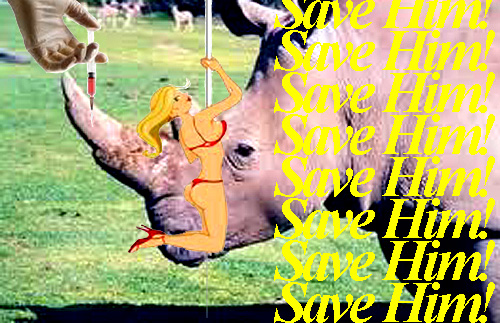
South Africans aren’t ones to mince their chew. And it isn’t just that outdoorsman independence and fierce loyalty to the wild. Before the economic downturn this goliath of African economies was surging, and tourism had surged within from 4.6% of GDP to 8.3%.
Consider this as a reference on the importance of wild and tourism and animals in South Africa, compared to our dear safari countries in East Africa. Nine times as many tourists to South Africa in 2007 as in all of East Africa contributed to South Africa’s GDP just a few billion less than the entire economies of either Kenya or Tanzania!
So it is not just that rhinos in South Africa are endangered but that a big chunk of the economy is endangered.
I wrote earlier this year about the horrific plot by farm managers in South Africa to butcher rhino for the black market. This week the International Rhino Foundation reported that 289 rhinos had been poached in South Africa so far this year, “the highest in more than 100 years.”
Within South Africa, the phrase now circulating is that a rhino is poached there every 30 hours.
Local farmers, tour managers and environmentalists have reacted with what I consider hysteria. The blogosphere is filled with calls to execute the many alleged poachers currently in custody. In typical political cow-towing to the reaction, today in South Africa’s Parliament, the Minister of Justice was charged with dropping prosecution against known poachers.
(The Government hasn’t dropped the investigations.)
False equivalences are flying. Rhino owners are citing government expenses, for travel of diplomats and other officials for example, as funds misplaced that could be used for stopping the poaching.
But the most outlandish reaction appeared last week. The owner/founder of a game reserve near Johannesburg told a local news outlet that he was considering injecting cyanide into the horns of his rhino.
Ed Hern said, “We wanted to inflict the same kind of suffering our animals had to endure on anyone involved in the vile activity of poaching.”
“We began researching the possibility of poisoning our rhinos’ horns, so any individual who knowingly handled or consumed the horn would either become seriously ill, or even face the risk of death.”
South Africa never does anything half way. Today a strip joint in Joburg pledged 50,000 Rand (about $8,000) from its take this weekend.
This is hysteria…cal.
A single rhino horn now commands up to $10,000 on the black market in South Africa, before it’s sent usually to Asia. South African officials are pretty much in control of at least understanding what’s happening.
The World Wildlife Fund with the government’s blessing has organized a special unit to deal with the upsurge in rhino poaching in South Africa.
WWF and South Africa, for instance, have identified Vietnam as the main market. They’ve identified a new belief there that powdered rhino horn cures such ailments as cancer, as modern diseases emerge in what was a non-modern society.
One hysteria leads to another.
There is also no doubt that the global economic realignment that started several years ago is devastating tourism in Africa. Even while African countries are doing extremely well relative to the rest of the world, tourism within those economies has been hit extremely hard.
No better poaching expert than men who were laid off from anti-poaching patrols.
The upsurge in rhino poaching in South Africa is terrible. And it’s real. But killing or teasing the killers won’t solve the problem.

